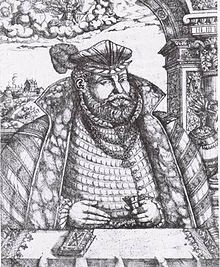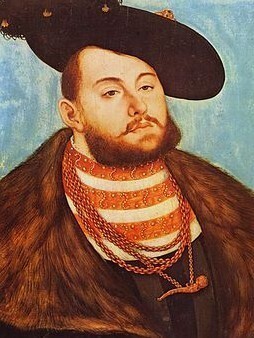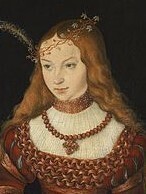Families Klein, Ree, de Breed en de Vries van Terschelling » Johan Frederik II. van Saksen-Weimar (1529-1595)
Données personnelles Johan Frederik II. van Saksen-Weimar
Source 1- Il est né le 8 janvier 1529.
- Il est décédé le 19 mai 1595 dans Stegr, il avait 66 ans.
- Un enfant de Johan Frederik I. van Saksen-Weimar et Sibylla van Kleef
Famille de Johan Frederik II. van Saksen-Weimar
(1) Il est marié avec Agnes van Hessen.
Ils se sont mariés le 26 mai 1555 à Weimar, D, il avait 26 ans.
(2) Il a/avait une relation avec Elisabeth van de Palts.
Enfant(s):
- Johan Casimir van Saksen-Coburg 1564-1633
Notes par Johan Frederik II. van Saksen-Weimar
John Frederick II of Saxony (8 January 1529 – 19 May 1595), was duke of Saxony, and briefly, Elector of Saxony (1554–1556).
He was the eldest son of John Frederick I, Elector of Saxony, and Sybille of Cleves.
Reign and military ambitions
After the Battle of Mühlberg (24 April 1547) and the capture of his father, John Frederick II, along with his brother John William, succeeded their father as the regents of the lands still retained by their family. After the death of their father (1554), the brothers amicably divided the lands that were inherited from their father; even so, John Frederick II, remained as the exclusive regent for the family possessions. And even though he received Eisenach and Coburg in the divisionary treaty, John Frederick II chose Gotha as his place of residence while serving as head of the family.
John Frederick's political aspirations were still directed towards the reinstatement of his family's right to the title of "Elector of Saxony," as well as the re-establishment of the lands that were lost due to his father's imprisonment. He briefly recovered the title of Elector of Saxony during 1554-1556, likewise he also reacquired the anger of the Emperor, Maximilian II, due to his involvement in several intrigues. In 1563 his prized general, Wilhelm von Grumbach attackedWürzburg, seized and plundered the city and compelled the chapter and the bishop to restore his lands. He was consequently placed under the imperial ban, but John Frederick II refused to obey the order of the Emperor Maximilian II to withdraw his forces. Meanwhile, Grumbach plotted the assassination of Saxon elector, Augustus; and proclamations were issued asking for assistance. Because of this, an end to alliances both inside and outside of Germany came about.
In November 1566 John Frederick was placed under the imperial ban, which had been placed against Grumbach earlier in the year, and Augustus marched against Gotha. Resistance from the people of Gotha was not forthcoming, and a mutiny led to the defeat of the town. Grumbach was delivered to his foes, and after being tortured, was executed at Gotha on 18 April 1567.
The Emperor imposed the Reichsacht (Imperial Ban) over John Frederick II, the current Elector of Saxony. The Reichsexekution, [more or less an intervention against a single ruler of a city state by an amalgamation of other city states in order to maintain the good of the entire empire] was also put into effect, in which John William, John Frederick's own brother, took part. After a siege of his castle in Gotha in 1566, John Frederick was eventually defeated and spent the rest of his life as an imperial prisoner. His possessions were confiscated by the emperor and handed over to John William, who became the sole ruler of the whole duchy of Saxony.
[edit]Marriage and children
In Weimar on 26 May 1555 John Frederick II married his first wife Agnes of Hesse, Dowager Electress of Saxony. Six months later she suffered a miscarriage and died, on 4 November 1555.
In Weimar on 12 June 1558 John Frederick II married his second wife Countess Palatine Elisabeth of Simmern-Sponheim, daughter of the later (1559) Frederick III, Elector Palatine. They had four sons:
- John Frederick (b. Weimar, 30 November 1559 – d. Weimar, 8 August 1560)
- Frederick Henry (b. Heldburg, 3 February 1563 – d. Eisenberg, 4 August 1572)
- John Casimir, Duke of Saxe-Coburg (b. Gotha, 12 June 1564 – d. Coburg, 16 July 1633)
- John Ernest, Duke of Saxe-Eisenach (b. Gotha, 9 July 1566 – d. Eisenach, 23 October 1638)
[edit]Succession
Later, the Emperor used the two surviving sons of John Frederick II against their uncle, John William; in 1572 the Division of Erfurt was made. The duchy of Saxony was divided into three parts. The older son, John Casimir, received Coburg, and the younger, John Ernest, received Eisenach. John William retained only the smaller part, the limited region of Weimar, but he added to his duchy the districts of Altenburg, Gothaand Meiningen. Since it has several Ernestine dynasties, Thuringia was also given in this division, the total possession of the Wettins (the duchy of Saxony) that had always bordered each other were no longer combined. From John William descends the house of Saxe-Weimar and the first house of Saxe-Altenburg, which separated later from Saxe-Weimar.
Barre chronologique Johan Frederik II. van Saksen-Weimar
 grand-parents
grand-parents
 parents
parents
 frères/soeurs
frères/soeurs
 enfants
enfants
Ancêtres (et descendants) de Johan Frederik II. van Saksen-Weimar
Johan Frederik II. van Saksen-Weimar  | ||||||||||||||||||||||||||||||||||
(1) 1555 | ||||||||||||||||||||||||||||||||||
Agnes van Hessen | ||||||||||||||||||||||||||||||||||
(2) | ||||||||||||||||||||||||||||||||||
Elisabeth van de Palts | ||||||||||||||||||||||||||||||||||
Les sources
- Cardinaal Web Site, Nick Cardinaal, Johan Friedrich II von Sachsen- Coburg u. Eisenach, 14 janvier 2014
Added by confirming a Smart Match
MyHeritage.com family tree Family site: Cardinaal Web Site Family tree: cardi221111
Événements historiques
Jour de naissance 8 janvier 1529
- En l'an 1529: Source: Wikipedia
- 22 avril » traité de Saragosse.
- 21 juin » victoire de Charles Quint sur François I, à la bataille de Landriano.
- 5 juillet » les cortèges royaux des deux parties, la française et l'impériale, entrent dans Cambrai pour des négociations. La Paix des Dames en ressortira, signée le 3 août suivant (traité de Cambrai).
- 3 août » signature de la paix des Dames (ou traité de Cambrai), pour mettre fin à la guerre entre la France et les Habsbourg, à Cambrai où les cortèges royaux des deux parties étaient entrés pour négocier le 5 juillet précédent.
- 5 août » paix des Dames (entre Louise de Savoie, mère de François Ier, et Marguerite d'Autriche, marraine de Charles Quint) / traité de Cambrai, trêve, en vue de la libération des deux aînés des fils de François, les dauphins, en titre et à venir.
- 27 septembre » le premier siège de Vienne par les Ottomans débute.
Jour du mariage 26 mai 1555
- En l'an 1555: Source: Wikipedia
- 24 février » abdication de Charles Quint.
- 25 mars » fondation de la ville de Valencia, au Vénézuela.
- 25 septembre » paix d'Augsbourg entre catholiques et protestants.
- 29 septembre » paix d'Augsbourg. Paix entre les États luthériens et les États catholiques allemands.
- 25 octobre » abdication de Charles Quint.
Jour du décès 19 mai 1595
- En l'an 1595: Source: Wikipedia
- 23 août » combats indécis entre Michel le Brave et Koca Sinan Pacha à la bataille de Călugăreni pendant la Longue Guerre.
- 18 septembre » Henri IV est reconnu par le pape Clément VIII.
- 23 décembre » signature de l'Union de Brest, une partie de l'Église orthodoxe des provinces ruthènes de la République polono-lituanienne (situées majoritairement dans la Biélorussie et l'Ukraine actuelles) font allégeance à Rome.
Même jour de naissance/décès
- 1626 » Jean Talon, premier intendant de la Nouvelle-France († 23 novembre 1694).
- 1635 » Luis Manuel Fernández Portocarrero, cardinal espagnol († 14 septembre 1709).
- 1770 » Jerónimo José Candido, matador espagnol († 1 avril 1839).
- 1819 » Françoise Schervier, religieuse allemande fondatrice des sœurs des pauvres de Saint François († 14 décembre 1876).
- 1821 » James Longstreet, général sudiste († 2 janvier 1904).
- 1822 » Carlo Alfredo Piatti, violoncelliste et compositeur italien († 18 juillet 1901).
- 1389 » Dimitri I Donskoï, grand prince de Moscou (° 12 octobre 1350).
- 1526 » Go-Kashiwabara, empereur du Japon (° 19 novembre 1464).
- 1536 » Anne Boleyn, reine d'Angleterre, deuxième épouse du roi Henri VIII (° vers 1501~1507).
- 1612 » Gregorio Petrocchini, prélat italien (° 1535).
- 1645 » Miyamoto Musashi, samouraï japonais (° 1584) - (19 mai du calendrier japonais mais 13 juin du calendrier grégorien).
- 1715 » Charles Montagu, 1comte de Halifax (° 16 avril 1661).
Sur le nom de famille Van Saksen-Weimar
- Afficher les informations que Genealogie Online a concernant le patronyme Van Saksen-Weimar.
- Afficher des informations sur Van Saksen-Weimar sur le site Archives Ouvertes.
- Trouvez dans le registre Wie (onder)zoekt wie? qui recherche le nom de famille Van Saksen-Weimar.
Marthan Klein, "Families Klein, Ree, de Breed en de Vries van Terschelling", base de données, Généalogie Online (https://www.genealogieonline.nl/families-klein-ree-ea/I38308.php : consultée 28 mai 2024), "Johan Frederik II. van Saksen-Weimar (1529-1595)".





